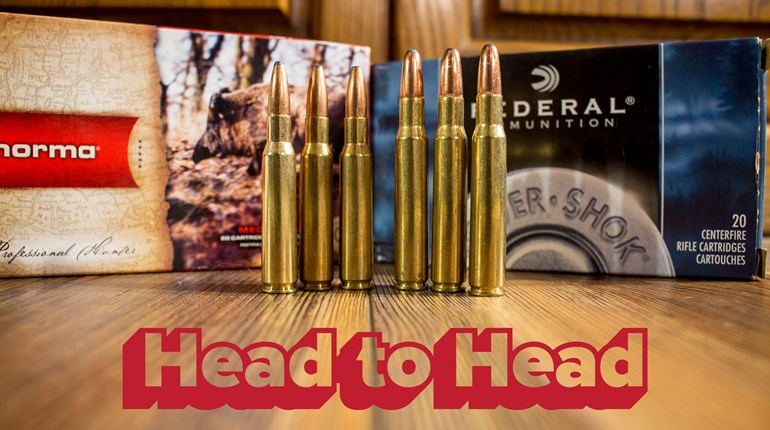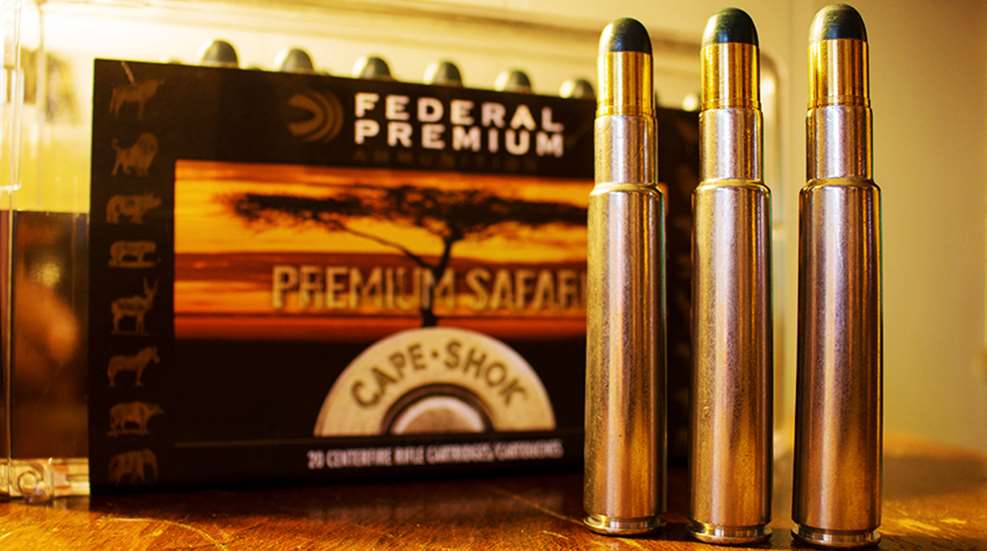
“He had a dirty, rusty-looking .416 bolt-action rifle in his hand. He told me once that it could not hit anything but lions.”
– Robert Ruark, Horn of the Hunter
So wrote Bwana Bob, in regards to one of the most famous professional hunters ever to grace the field, the inimitable Harry Selby. And it’s sort of funny, just exactly how that sentence came to be written. Harry’s boss, Donald Ker, had his own hunting clients out on safari in Kenya, and the two hunting parties met by chance. One problem: Harry had laid his .470 NE double rifle on the ground behind the Land Rover, and Donald proceeded to run it over, rendering it useless. The only replacement Selby could procure was the aforementioned Rigby, which would become an icon. Had Ruark not mentioned that rifle—of which less than 200 were made prior to the World War II—the .416 Rigby and the .416-inch bore might have slipped into obscurity.
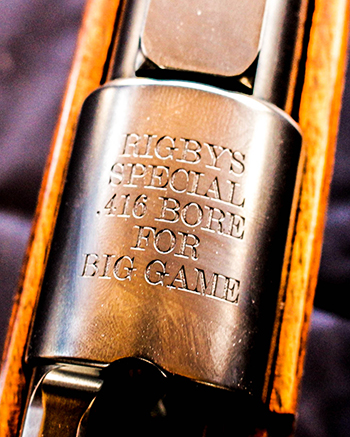 “Rigby’s Special .416 Bore for Big Game,” so reads the inscription on a modern Rigby rifle, and it is aptly worded. Released in 1911, the big .416 Rigby didn’t take long to become a favorite among the professional hunters and visiting sportsman alike. Those few that had a .416 Rigby sang its praises—including John ‘Pondoro’ Taylor, whose African Rifles and Cartridges remains a favorite—and while the older .404 Jeffery saw much more action, especially in the hands of game rangers throughout eastern and southern Africa, the .416 Rigby was made famous in Ruark’s 1953 novel. In spite of some modern iterations of the .416 Rigby’s ballistic formula—and I am a huge fan of the .416 Remington—the classic cartridge maintains a fervent following to this day.
“Rigby’s Special .416 Bore for Big Game,” so reads the inscription on a modern Rigby rifle, and it is aptly worded. Released in 1911, the big .416 Rigby didn’t take long to become a favorite among the professional hunters and visiting sportsman alike. Those few that had a .416 Rigby sang its praises—including John ‘Pondoro’ Taylor, whose African Rifles and Cartridges remains a favorite—and while the older .404 Jeffery saw much more action, especially in the hands of game rangers throughout eastern and southern Africa, the .416 Rigby was made famous in Ruark’s 1953 novel. In spite of some modern iterations of the .416 Rigby’s ballistic formula—and I am a huge fan of the .416 Remington—the classic cartridge maintains a fervent following to this day.
The .416 Rigby case came after the release of the .350 Rigby Magnum, which was a popular choice for a light rifle at that time, and offered a voluminous case in order to keep pressures low in the tropical heat of India and Africa. Cordite, the propellant du jour, was extremely sensitive to temperature changes, and many smaller cases gave extraction issues in the terrible heat of the tropics. Using a rimless design, with a steep 45-degree shoulder for good headspacing, Rigby absolutely nailed the formula, with a 410-grain bullet propelled at 2390 fps, for just over 5,000 ft.-lbs. of energy, and it soon developed an excellent reputation for deep penetration on all big game animals, including elephant and rhino. The high sectional density values of the 410-grain bullet (0.338) and even the modern 400-grain bullet (0.330) guarantee that the solids will reach the brain of the biggest bull elephant and the soft points would give excellent penetration, destroying vital tissue and putting dangerous game down fast. And, while the .416 Rigby has enough recoil to let you know its capabilities, it isn’t so much as to be described as unmanageable.
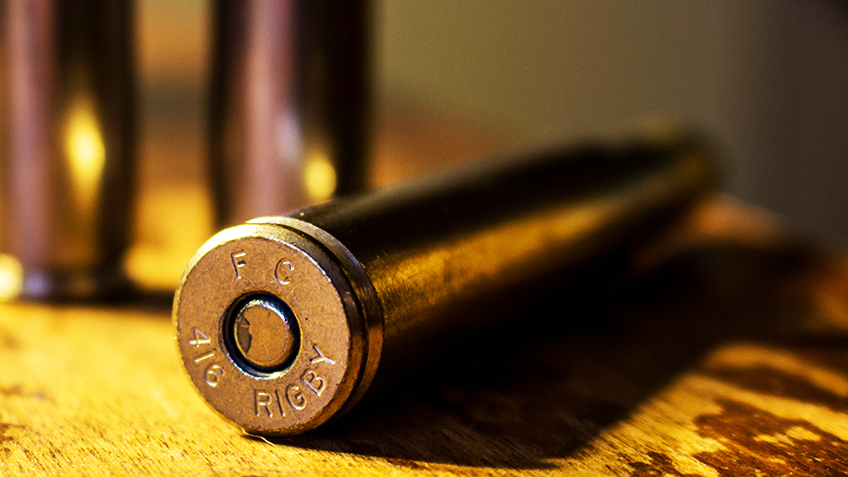
In the grand scheme of things, the .416 Rigby isn’t considered a true stopping rifle in the way that a .500 NE or the big .577 NE are, but that 400-grain bullet is a very effective choice. The .416 Rigby lacks the versatility that the .375 H&H possesses, in that with lighter bullets, the .375 makes a great choice for plains game in Africa as well as elk, moose and bear here in the United States. But for big game, the visual difference in impact on buffalo (on any continent) and other heavyweights is fast apparent.
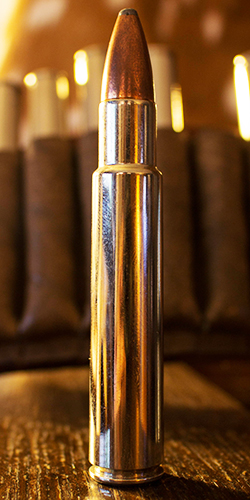 Modern .416 Rigby loads use a 400-grain bullet at either 2350 fps or 2400 fps, depending on brand, though there are 350-grain and 450-grain choices available in factory ammo, and even more versatility is afforded to the handloader. I’m a big fan of the Norma African PH load using 450-grain Woodleigh softpoints and solids at 2150 fps, and Federal loads the Trophy Bonded Bear Claw softpoint and Sledgehammer solid, in addition to the Swift A-Frame and Woodleigh Hydrostatically Stabilized Solid. Hornady loads their excellent 400-grain DGX Bonded softpoint and DGS solid; there is plenty to choose from for the owner of a good .416 Rigby, both in the ammunition and rifle departments. As the .416-inch diameter is a popular dangerous game choice, there are also plenty of component bullets to choose from, including monometals, bonded-core and traditional softpoints and solid (non-expanding) bullets.
Modern .416 Rigby loads use a 400-grain bullet at either 2350 fps or 2400 fps, depending on brand, though there are 350-grain and 450-grain choices available in factory ammo, and even more versatility is afforded to the handloader. I’m a big fan of the Norma African PH load using 450-grain Woodleigh softpoints and solids at 2150 fps, and Federal loads the Trophy Bonded Bear Claw softpoint and Sledgehammer solid, in addition to the Swift A-Frame and Woodleigh Hydrostatically Stabilized Solid. Hornady loads their excellent 400-grain DGX Bonded softpoint and DGS solid; there is plenty to choose from for the owner of a good .416 Rigby, both in the ammunition and rifle departments. As the .416-inch diameter is a popular dangerous game choice, there are also plenty of component bullets to choose from, including monometals, bonded-core and traditional softpoints and solid (non-expanding) bullets.
That huge case—measuring 2.900 inches—requires a magnum-length receiver, as when loaded the cartridge will measure 3.75 inches. If I had to find fault with the .416 Rigby, it’s in the diameter of the case, especially compared to the .416 Remington Magnum, which develops identical factory ballistics, albeit at a higher pressure. The Rigby takes up considerably more room in the magazine, though the argument can be made that there is also the advantage of higher velocity in the Rigby case, if that appeals to you.
I have found that the Rigby can easily digest over 100-grains of powder, so a large rifle magnum primer is required. For powder choices, I’ve had excellent results with Alliant’s Reloder 19 and 22, as well as IMR 4350 and Hodgdon’s H4831SC. I’ve also found that a 400-grain bullet at a muzzle velocity of 2250 fps (rather close to what some have found the original Rigby ammunition produced) has been not only very accurate, but considerably easier on the shoulder.
Unlike many of the larger Nitro Express cartridges, the trajectory of the .416 Rigby is rather flat-shooting, if using a spitzer bullet. Shots out to 200 and 300 yards are certainly possible, and I see no reason why a hunter shouldn’t practice out to those ranges. With a 200-yard zero, the 400-grain Swift A-Frame load from Federal will be 3.1 inches high at 100 yards, and 12.7 inches low at 300 yards, so should you find the kudu or sable of a lifetime at that range, you can feel confident in the shot.
There have been many other .416s over the years—the aforementioned .416 Remington Magnum, closely related to the .416 Hoffman, the .416 Taylor, the .416 Weatherby Magnum and of late the .416 Ruger—but none have done much to tarnish the reputation of John Rigby & Sons design.
I know of no professional hunter in a dangerous game camp who would wrinkle his nose at a client who showed up with a .416 Rigby in tow; it is one of those timeless cartridges which have both the pedigree and the performance to back it up. And, who could deny that the .416 Rigby possesses a ‘cool’ factor? The sheer size, the steep shoulder and the Rigby name all add up to a century-plus-old classic that isn’t going anywhere anytime soon.
Looking for previous installments of our "Behind the Bullet" series? We've got you covered.
• .358 Norma Magnum
• .22 LR
• 7mm-08 Remington
• 8mm Remington Magnum
• .338 Federal
• .224 Valkyrie
• .338-06 A-Square
• 9.3x62mm Mauser
• .257 Weatherby Magnum
• .45-70 Government
• .300 H&H Magnum
• .25-06 Remington
• .30-06 Springfield
• 6.5 Creedmoor
• .300 Remington Ultra Magnum
• 7mm Remington Magnum
• .470 Nitro Express
• .280 Remington
• .300 Winchester Magnum
• .270 Winchester
• .222 Remington
• .45 ACP
• .404 Jeffery
• .44 Remington Magnum
• .41 Remington Magnum
• .243 Winchester
• .338 Winchester Magnum
• .357 S&W Magnum
• 6.5-284 Norma
• 8x57 Mauser
• .38 Smith & Wesson Special
• 7x57mm Mauser
• 9 mm Luger
• .35 Whelen
• .454 Casull
• .375 H&H Magnum
• .45 Colt
• .22-250 Remington
• 10mm Auto
• .308 Winchester














